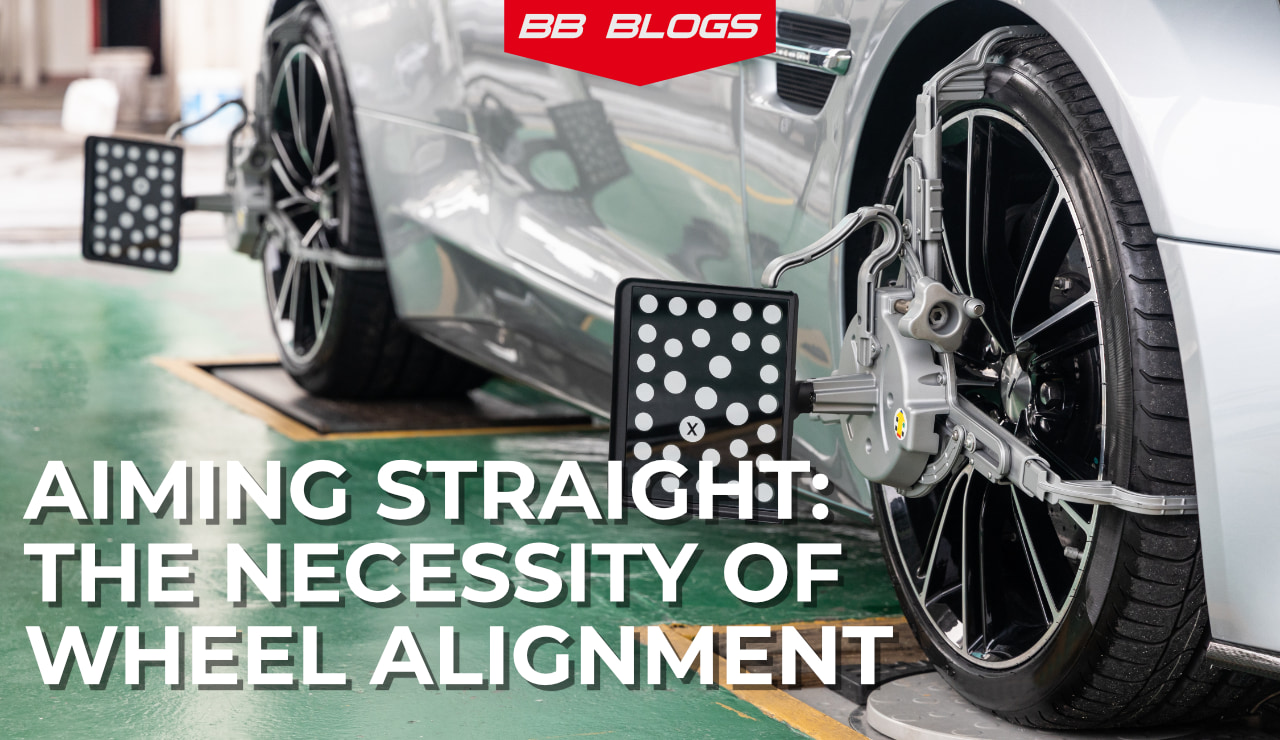Wheel Alignment: Steering Towards a Smooth and Safe Drive
Posted by BB Wheels on 6th Jul 2023

Wheel Alignment: Steering Towards a Smooth and Safe Drive
Wheel alignment, often overlooked amidst more obvious car maintenance routines like oil changes and tire rotations, is a critical aspect of car care. Its significance extends beyond simply ensuring a straight path; it affects your car's overall performance, longevity, and safety. The simple fact is that every driver needs to prioritize wheel alignment, so let's delve into its role and benefits.
Understanding Wheel Alignment
Wheel alignment is a mechanical process that ensures your car's wheels are set to the manufacturer's specifications, regarding three key factors: camber, toe, and caster.
Camber refers to the wheel's inward or outward angle when viewed from the front of the vehicle. If the top of the wheel leans out from the car, you have positive camber, while negative camber refers to the wheel leaning towards the car.
Toe alignment, on the other hand, is a measure of the extent to which your tires turn inward or outward when viewed from above. If your tires are turned towards each other, that's called toe-in alignment. Conversely, if they turn away from each other, that's toe-out alignment.
Caster angle is a bit more complex. It refers to the angle of your steering axis when viewed from the side of your vehicle. If the steering axis tilts towards the driver, it's considered positive caster, and if it tilts towards the front, it's negative caster.
When these angles are out of alignment according to the manufacturer's specifications, it can lead to an array of problems for your vehicle.
Is Wheel Alignment the Same as Balancing?
One common misconception in the realm of automotive maintenance is the conflation of wheel alignment and tire balancing. While both services aim to optimize the performance and safety of your vehicle, they address distinct issues.
Wheel alignment pertains to adjusting the angles of your vehicle's wheels so they are parallel to each other and perpendicular to the ground. Misalignment can result from normal wear and tear, or from incidents such as hitting a pothole or curb. This process requires sophisticated equipment and trained technicians to adjust the camber, caster, and toe angles as per the manufacturer's specifications.
On the other hand, tire balancing is an entirely different process. Over time, tires and wheels may not have weight distributed evenly around their circumference, leading to imbalances. This can cause vibration or wobble when the tires spin, especially at high speeds, and result in uneven tire wear, reduced fuel efficiency, and a less comfortable ride. Tire balancing compensates for these weight imbalances. It involves attaching small weights to the wheel to ensure that the tire and wheel assembly spins smoothly. Like alignment, balancing is a complex process that should be left to professionals.
It's important to note that while both alignment and balancing play crucial roles in maintaining your vehicle's performance and your safety, they are not interchangeable. Both should be a part of your regular vehicle maintenance schedule. Tire balancing is usually done when tires are rotated, typically every 5,000 to 7,500 miles, while wheel alignment checks should be carried out every two to three years, depending on your vehicle manufacturer's recommendations and your driving habits.
In essence, understanding the difference between wheel alignment and tire balancing can empower you as a car owner to make informed decisions about your vehicle's maintenance, ensuring a smoother and safer ride for you and your passengers.
The Importance of Wheel Alignment
Prolongs Tire Life: Misaligned wheels can lead to uneven tire wear, thereby shortening the lifespan of your tires. In the long run, regular alignment checks can save you from premature, and often expensive, tire replacement.
Improves Fuel Efficiency: Misalignment can increase the rolling resistance of the tires. This makes the vehicle work harder, thus using more fuel. Proper alignment can reduce this resistance, leading to improved fuel efficiency.
Enhances Safety: A misaligned car can pull to one side, making it more difficult to control. This is not only inconvenient but can also be dangerous, especially during emergencies. Keeping wheels aligned helps ensure stability and optimal control of your vehicle.
Delivers a Smoother Ride: A car with properly aligned wheels offers a more comfortable driving experience. It prevents the vehicle from veering to one side, and reduces vibrations that can lead to driver fatigue.
Detecting Wheel Misalignment
While a professional mechanic is equipped to diagnose and fix wheel alignment issues, there are some signs you can watch out for:
- The vehicle pulls to one side while driving on a straight, flat road.
- The steering wheel is off-center when driving straight.
- Rapid or uneven tire wear.
- The steering wheel vibrates when driving.
When to Check Wheel Alignment
Manufacturers generally recommend a wheel alignment check every two to three years. However, there are instances when you might need one sooner:
- After hitting a major bump or a pothole.
- If new tires are installed.
- If suspension parts have been replaced.
- If you've driven a certain number of miles, as specified by your car's manufacturer.
In conclusion, proper wheel alignment is not merely a matter of a smooth drive, but a critical aspect of vehicle maintenance that impacts safety, performance, and the overall lifespan of your vehicle. Regular checks and adjustments can save you money, keep you safer on the road, and make your driving experience more enjoyable. So the next time you're scheduling car maintenance, remember to add a wheel alignment check to your list. After all, in the grand scheme of automotive care, ensuring a smooth and straight ride is indeed a matter of aligning with safety and performance.

